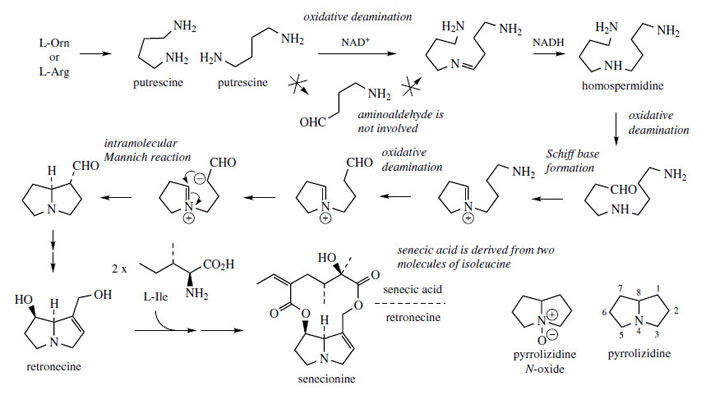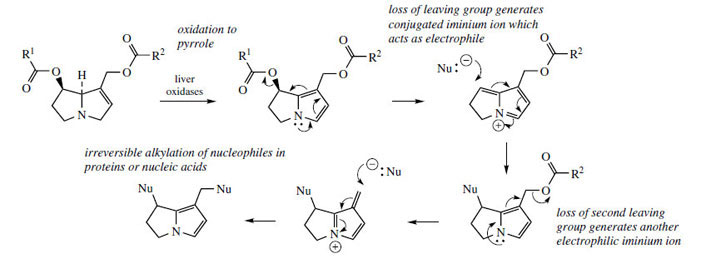Pyrrolizidine Alkaloids
Two molecules of ornithine are utilized in formation of the bicyclic pyrrolizidine skeleton, the pathway (Figure 18) proceeding via the intermediate putrescine. Because plants synthesizing pyrrolizidine alkaloids appear to lack the decarboxylase enzyme transforming ornithine into putrescine, ornithine is actually incorporated by way of arginine (Figure 2). Two molecules of putrescine are condensed in an NAD+-dependent oxidative deamination reaction to give the imine, which is then converted into homospermidine by NADH reduction. On paper, one might predict that one molecule of putrescine is converted by oxidative deamination into the aldehyde, which condenses with a second putrescine molecule to give the imine, but this mechanism has been proven to be incorrect. The pyrrolizidine skeleton is formed from homospermidine by a sequence of oxidative deamination, imine formation, and an intramolecular Mannich reaction, which exploits the enolate anion generated from the aldehyde. This latter reaction is analogous to that proposed in formation of the tropane ring system. A typical simple natural pyrrolizidine structure is that of retronecine (Figure 18), which can be derived from the pyrrolizidine aldehyde by modest oxidative and reductive steps. The pyrrolizidine skeleton thus incorporates a C4N unit from ornithine, plus a further four carbons from the same amino acid precursor.Pyrrolizidine alkaloids have a wide distribution, but are characteristic of certain genera of the Boraginaceae (e.g. Heliotropium, Cynoglossum, and Symphytum), the Compositae/Asteraceae (e.g. Senecio) and the Leguminosae/Fabaceae (e.g. Crotalaria). The pyrrolizidine bases rarely occur in the free form, but are generally found as esters with rare mono- or di-basic acids, the necic acids. Thus, senecionine (Figure 18) from Senecio species is a diester of retronecine with senecic acid. Inspection of the ten-carbon skeleton of senecic acid suggests it is potentially derivable from two isoprene units, but experimental evidence has demonstrated that it is in fact obtained by incorporation of two molecules of the amino acid L-isoleucine. Loss of the carboxyl from isoleucine supplies a carbon fragment analogous to isoprene units (compare tiglic acid in the tropane alkaloid meteloidine, Figure 5). Other necic acid structures may incorporate fragments from valine, threonine, leucine, or acetate. It is also worthy of note that, in general, the pyrrolizidine alkaloids accumulate in the plant as polar Noxides, facilitating their transport, and above all, maintaining them in a non-toxic form. The Noxides are easily changed back to the tertiary amines by mild reduction, as will occur in the gut of a herbivore.
 |
| Figure 18 |
Many pyrrolizidine alkaloids are known to produce pronounced hepatic toxicity and there are many recorded cases of livestock poisoning. Potentially toxic structures have 1,2-unsaturation in the pyrrolizidine ring and an ester function on the side-chain. Although themselves non-toxic, these alkaloids are transformed by mammalian liver oxidases into reactive pyrrole structures, which are potent alkylating agents and react with suitable cell nucleophiles, e.g. nucleic acids and proteins (Figure 19). N-oxides are not transformed by these oxidases, only the free bases. The presence of pyrrolizidine alkaloids, e.g. acetyl-intermedine and acetyl-lycopsamine (Figure 20) in medicinal comfrey (Symphytum officinale; Boraginaceae) has emphasized potential dangers of using this traditional herbal drug as a remedy for inflammatory, rheumatic, and gastrointestinal disorders. Prolonged usage may lead to liver damage. Caterpillars of the cinnabar moth Tyria jacobaeae feed on species of Senecio (e.g. ragwort, S. jacobaea, and groundsel, S. vulgaris) with impunity, building up levels of pyrrolizidine alkaloids in their bodies (in the form of non-toxic N-oxides) making them distasteful to predators, and potentially toxic should the predator convert the alkaloids into the free bases. Indicine-N-oxide (Figure 20) from Heliotropium indicum (Boraginaceae) demonstrated significant antileukaemic activity in clinical trials but undesirable hepatotoxicity prevented any further development.
 |
| Figure 19 |
 |
| Figure 20 |
The tobacco alkaloids, especially nicotine, are derived from nicotinic acid but also contain a pyrrolidine ring system derived from ornithine as a portion of their structure.




